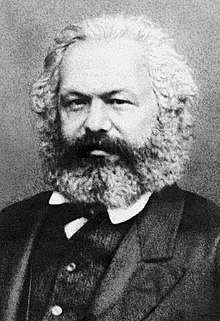The Belgian Massacres
"The Belgian Massacres. To the Workmen of Europe and the United States" was a political pamphlet written by Karl Marx in May 1869.
 Karl Marx, pictured in 1869. | |
| Author | Karl Marx |
|---|---|
| Language | French; English |
| Subject | State repression of strikes and class conflict in Belgium |
Publication date | 1869 |
| Media type | |
| Preceded by | Value, Price and Profit (1865) |
| Followed by | The Civil War in France (1871) |
Background
Socialism, as a political ideology, first emerged in Belgium in the second-half of the nineteenth century. The reign of Leopold II (1865–1909) saw the rise of organized socialist political groups and parties, most notably among the industrial workers in the southern region of Wallonia. Trade unions were legalized in 1866, opening the way to organized labor politics.[1] The International Workingmen's Association held its first conference outside Switzerland in Brussels in 1868 as Belgian socialism, under figures such as César De Paepe, expanded dramatically.[2] In April 1869, a strike broke out in the Walloon towns of Seraing and Frameries which was repressed with violence. At least nine strikers were killed by the Garde Civique during the ensuing confrontation. A detailed report of the strike was provided to the International by the Belgian socialist Eugène Hins.
Text
Marx's pamphlet was prepared in French and English versions and presented to the General Council of the International on 4 May 1869. It was subsequently republished in a number of Belgian and European newspapers.
In the text, Marx contrasts the relative acceptance of strikes in England and the United States with the aggressive posture taken in Belgium. He writes:
There exists but one country in the civilised world where every strike is eagerly and joyously turned into a pretext for the official massacre of the Working Class. That country of single blessedness is Belgium! the model state of continental constitutionalism, the snug, well-hedged, little paradise of the landlord, the capitalist, and the priest. The earth performs not more surely its yearly revolution than the Belgian Government its yearly Working Men’s massacre. The massacre of this year does not differ from last year’s massacre, but by the ghastlier number of its victims, the more hideous ferocity of an otherwise ridiculous army, the noisier jubilation of the clerical and capitalist press, and the intensified frivolity of the pretexts put forward by the Governmental butchers.
Marx suggests several explanations for the violent repression of the strike. He considers that the rioting which was used to justify the intervention was provoked by the Belgian military and that Belgian political and commercial interests were complicit. He also suggests it was deliberately escalated to send a political message to the French emperor, Napoleon III and compares it to the British repression of the Morant Bay rebellion of 1865. Ultimately, he attacks the Belgian government for "conspicuously playing the gendarme of capital against labour" and considers that weakening of proletarian support for Belgian independence risked enabling the Great Powers to annex the country. He calls for money to be collected by workers from Europe and the United States to compensate the families of the workers killed.
References
- Dumont 1996, p. 110.
- Dumont 1996, p. 112.
Bibliography
- Dumont, Georges-Henri (1996). La Vie Quotidienne en Belgique sous la Règne de Léopold II (1865–1909) (in French) (Rev. ed.). Brussels: Éd. Le Cri. ISBN 2-87106-173-4.CS1 maint: ref=harv (link)
External links
- The Belgian Massacres text at Marxist Internet Archive